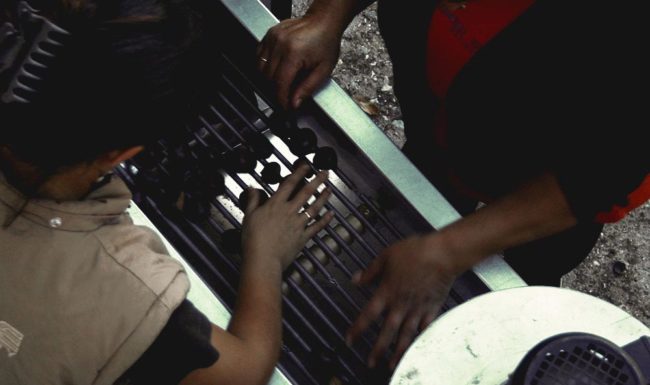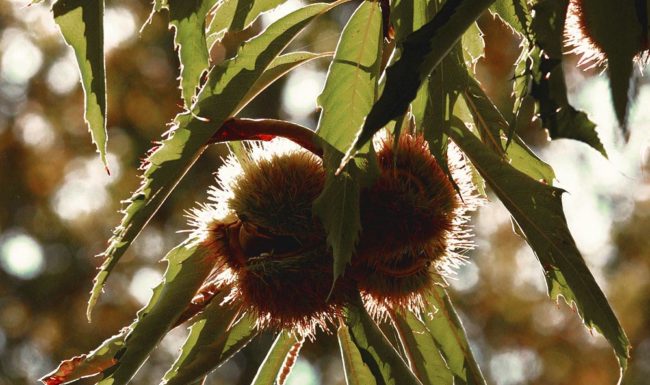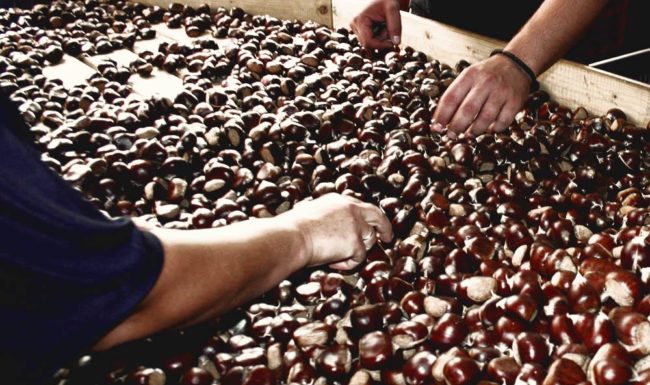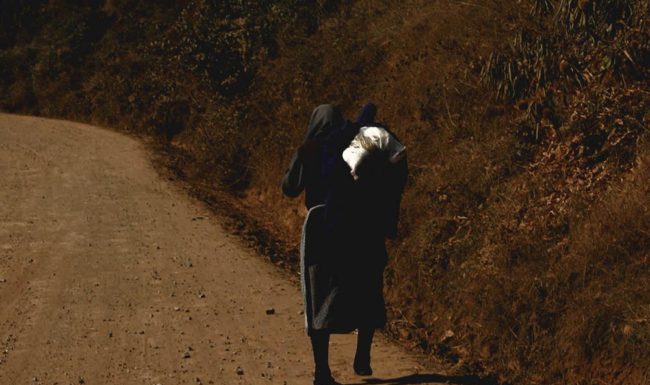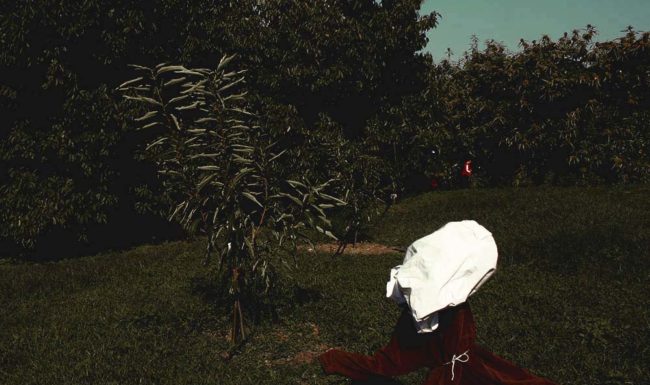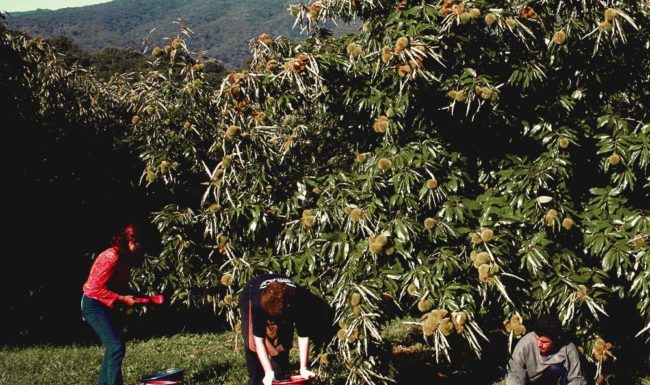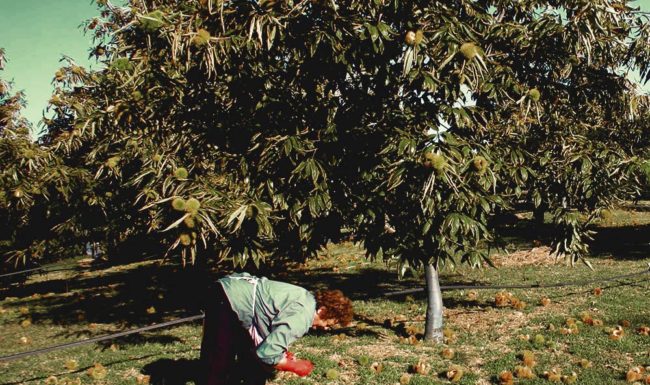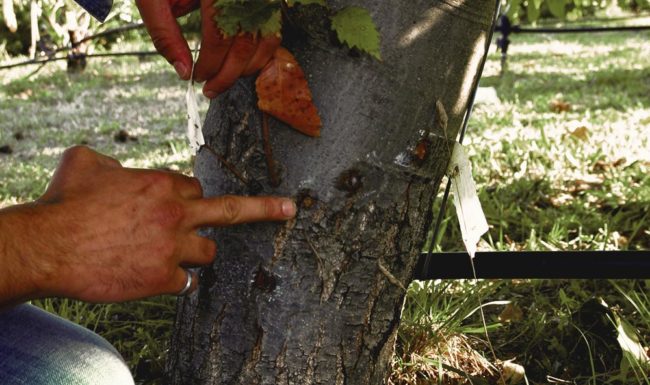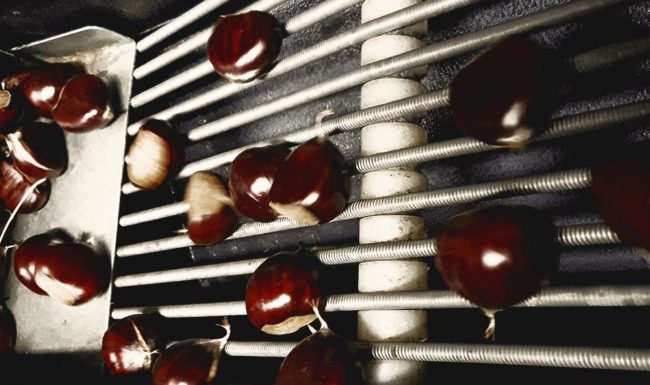The most quality Chestnuts from Ossa (Kissavos) mountain.
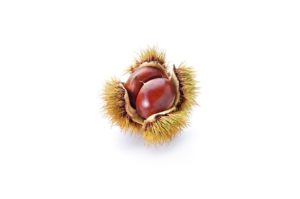
CHESTNUT OF MELIVIA 
Castanea Sativa (European Chestnut)
It is the fruit of the chestnut tree, a genus of kypeloforon, which matures in thorny enclosure (katsida, or katsouda, or tzoyna) and when it opens, the nuts fall to the ground, from where they’re collected.The chestnut is one of the most exquisite grown dishes, and it has been known in Greece, since several centuries before Christ. In terms of production, quality and trading during the last decades it has been associated with the municipal section of Melivia and particularly with the local community of Melivia , on the East side of mount Kissavos. This is an area with abundant water on rich ground with fertile and not consistent nor limestone soil. With solar energy and the excellent climatic conditions combined, the ideal requirements for cultivation and the specificity of the quality of the product, are formed.Undeniably the reputation of the Melivia Chestnut has passed the narrow national boundaries, so its brand awareness compared to other similar products, both on the domestic and on the international market, is now granted. Therefore the effort made by the cooperative to register it as a Pdo product is understandable. The specificity of the product lies in the fact that the Melivia Chestnut, in comparison to other region chestnuts, stands out for its size, shine, durability, taste, nutritional value and digestibility, in any way it is consumed.It is a product rich in starch and various proteins and can be eaten raw, roasted, boiled, and cooked with meat. Lately it is quite popular in the confectionery and milling industry.Its presence, cultivation and trading from the region of Melivia isn’t something new. It dates back to the ancient Greek years and it was one of the main export products of the city along with oil, wine, the colour purple and balm oil. According to historical testimonies we find it in ancient Greece with various names:
- Evian Karyon (unlike Persian Karyon =nut and Pontian Karyon= hazelnut )
- Kastanaikon Karyon
- Sardiani glans
- moton
- lopimon
- Zeus acorn= sweet chestnut (apparently this is the product of grafted chestnut unlike the fruit of the wild chestnut ) .
The reasons that lead us to effortlessly support the belief that the cultivation and trading of the chestnut is linked, from the ancient times, to the coastal Eastern foothills of the mountain complex of Kissavos – Montenegro, regardless of the same product appearing in other geographic regions of the world as it was known, are basically the following:
- Given the limits of ancient Magnesia, which stretched from the Pagasitic Bay, to the mouth of the Pinios river in Tempi Valley, we are referring to an area at the bottom of Mountains Pelion, Montenegro and Kissavos, with a continuous dense vegetation of chestnut trees, wild and grafted, from the mythical times until today. Geographically Melivia is right in the center of the magnetic field.
- Given that the ancient Greeks gave to many areas the names of the trees thrived in them, in the magnetic field we see that something similar happened with the city Kasthanaia or Kasthanea or Kastanea. This is a beautiful town very close to Melivia with which trade was developed. Kasthanaia, known like Melivia and Ipnoi from the Persian wreck in 480 b.c., was approximately located in the area south of the village of Sklithro and had developed quite a lot of activity with the production and distribution of chestnuts, clearly in cooperation with Melivia.
- Melivia, in a key geographical location, in a coastal hub in the heart of the Western Aegean Sea, was a commerce center and its activity of import and export trade, had expanded up to the coast and to Cyrene Libya. Of course the export trade includes the chestnut along with oil, wine, the colour purple and balm oil.
- The fact that in the coastal foothills of Magnesia and particularly in the mountainous complex of Kissavos – Montenegro, the chestnut tree along with its other relative kypelofora (oak, Aryan, yew) is self sown, proves that this tree is indigenous. This is supported by the following: in any areas that residents had access to farming, the chestnut tree is grafted. On the contrary, where farming was not possible, the chestnut tree remained wild. Moreover, even since the natural societies it is self-evident throughout the world that residents of each region form an ecosystem similar to their natural resources. Was it possible that Melivia did not make the most of such a rich natural resource?
- The name of the product alone, Zeus Acorn = sweet chestnut, nut of a grafted chestnut, which was known in various regions of Greece, couldn’t but have been known in an area where its soil produced it and where the worshiping of Zeus was apparently widespread. (Zeus Extreme, Keravnios etc.). But also, even if approached from a mythical aspect, one cannot but accept that: such a dessert after the Ambrosia, the Father of the Gods reached his hand and took it from the so close to Olympus Melivia!The fact that the cultivation of chestnut in our region is mentioned in Roman times, in the Byzantine period and during the Turkish rule, leaves us only to accept the continuous and uninterrupted production and trading of this product over the centuries.
- But to accept that a product imported firstly from Paphlagonia, as some argue, still doesn’t allow us to not support our opinion about the locality of chestnuts. Namely: what reasons would Melivia have to import a product that was self grown in its own territory? The inhabitants already knew how to produce and distribute in the market all the products that the Earth gave them. Vine, olive, madder. Therefore, the chestnut.
That being the case, since we accept the continuity of Melivia through time, from the mythical age until today, we must also accept the continuity of its products. A very simple deductive reasoning is needed so that everyone understands that the chestnut is interwoven with the history of Melivia.Today the annual chestnut production in Melivia amounts to 1,500 tonnes and is expected to grow every year, as a result of the renewal of the chestnut trees in the previous years.Melivia includes around 2,500 acres of Castanea Sativa (European Chestnut). It is important to mention that the kastanaria came to be, from the planting of the trees on privately owned land under normal planter links from 6 × 6 – 8 × 8 and a small percentage of forest land that were granted to farmers who, after they thinned them, they then grafted and exploited them.
Chestnut Soil and Climatic Requirements
The soil and climate are the most important factors determining the possibility of a chestnut plantation in an area. For the suitability of the soil, a chemical reaction of pH is prerequisite. The chestnut grows only in slightly acidic soils, for example soils with pH from 5.5 to 6, which is the most suitable. The presence of contrary active Ca even in very small concentrations or a pH greater than 6 hinder the cultivation of the chestnut.Suitable climatic conditions have to do with the topography and the location of the property. The Sun, the rain, the sea breeze, the Eastern orientation make up the ideal factors for qualitative and quantitative performance of the chestnut.
Nutrition
Chestnuts are eaten grilled, boiled or raw and contain many calories. Unlike other nuts, they contain less fat, while at the same time they are rich in minerals, vitamins and nutrients. They are a good source of dietary fiber, providing about 8.1 grams of fiber in every 100gr., That is 21% of the recommended daily amount. Dietary fiber can help bring down cholesterol levels, because it reduces its absorption into the blood and can be eaten by people who are gluten intolerant.Chestnuts also stand out, because of their high content of vitamin C, folic acid and monounsaturated fatty acids, preventing the appearance of disease in the heart and arteries.
ΚΑΣΤΑΝΟ ΜΕΛΙΒΟΙΑΣ 
Castanea Sativa (Ευρωπαϊκή καστανιά)
Πρόκειται για τον καρπό της καστανιάς, ενός γένους της τάξεως των κυπελλοφόρων, που ωριμάζει μέσα σε ακανθώδες περίβλημα (κατσίδα, ή κατσούδα, ή τζούνα) και όταν αυτό διανοίγεται, τότε οι καρποί πέφτουν στο έδαφος, απ’ όπου και συλλέγονται. Το κάστανο είναι ένα από τα πλέον εκλεκτά φυτικά εδέσματα, γνωστό στον Ελλαδικό χώρο αρκετούς αιώνες προ Χριστού. Όσον αφορά στην παραγωγή, την ποιότητα και τη διακίνησή του έχει συνδεθεί τις τελευταίες δεκαετίες με τη Δημοτική Ενότητα Μελιβοίας και ιδιαίτερα με την Τοπική Κοινότητα Μελιβοίας, στην ανατολική πλευρά του Κισσάβου. Πρόκειται για μια περιοχή με άφθονα νερά σε εύφορα χωματοβούνια με έδαφος γονιμότατο κι όχι συνεκτικό ούτε ασβεστολιθικό. Σε συνδυασμό βέβαια με την ηλιακή ενέργεια και τις άριστες κλιματολογικές συνθήκες διαμορφώνονται οι ιδανικές προϋποθέσεις για την καλλιέργεια και την ποιοτική ιδιαιτερότητα του συγκεκριμένου προϊόντος. Αναντίρρητα η φήμη του Κάστανου Μελιβοίας έχει περάσει τα στενά εθνικά όρια, οπότε η αναγνωρισιμότητά του έναντι άλλων ομοειδών προϊόντων, τόσο στην εγχώρια, όσο και στη διεθνή αγορά, είναι πλέον δεδομένη. Δικαιολογημένα λοιπόν γίνεται προσπάθεια από το Συνεταιρισμό να καταχωρηθεί ως προϊόν Π.Ο.Π. Η ιδιαιτερότητά του συνίσταται στο γεγονός ότι το Κάστανο Μελιβοίας σε σύγκριση με τα κάστανα άλλων περιοχών ξεχωρίζει για το μέγεθος, τη στιλπνότητα, την ανθεκτικότητα, τη γεύση, τη θρεπτική του αξία και την ευπεψία του, όπως κι αν καταναλώνεται. Είναι προϊόν πλούσιο σε άμυλο και διάφορες πρωτεΐνες και τρώγεται ωμό, ψητό, βραστό, αλλά και μαγειρεμένο με κρέας. Τελευταία είναι αρκετά διαδεδομένο στη ζαχαροπλαστική και την αλευροποιΐα. Η παρουσία, η καλλιέργεια και η διακίνησή του από την περιοχή της Μελιβοίας δεν είναι κάτι το καινούργιο. Ανάγεται στα αρχαία Ελληνικά χρόνια και ήταν ένα από τα κυριότερα εξαγωγικά προϊόντα της πόλης μαζί με το λάδι, το κρασί, την πορφύρα και το βαλσαμόλαδο. Σύμφωνα με τις ιστορικές μαρτυρίες το συναντούμε στην αρχαία Ελλάδα με διάφορες ονομασίες:
- Ευβοϊκόν κάρυον (σ’ αντίθεση με το Περσικόν κάρυον = καρύδι και το Ποντιακόν κάρυον = φουντούκι)
- Κασταναικόν κάρυον
- Σαρδιανή βάλανος
- μότον
- λόπιμον
- Διός βάλανος = το γλυκό κάστανο (προφανώς πρόκειται για το προϊόν της εμβολιασμένης καστανιάς σ’ αντίθεση με τον καρπό της άγριας).
Οι λόγοι που μας οδηγούν να υποστηρίξουμε αβίαστα την άποψη ότι η καλλιέργεια και η εμπορία του κάστανου συνδέεται απ’ τα Πανάρχαια χρόνια με τους παράλιους ανατολικούς πρόποδες στο ορεινό σύμπλεγμα Κισσάβου – Μαυροβουνίου, ανεξάρτητα από το αν το ίδιο προϊόν εμφανίζεται και σε άλλες γεωγραφικές περιοχές του τότε γνωστού κόσμου, είναι βασικά οι παρακάτω:
- Με δεδομένα τα όρια της αρχαίας Μαγνησίας, η οποία εκτείνονταν από τον Παγασητικό κόλπο μέχρι και την εκβολή του Πηνειού στα Τέμπη, φωτογραφίζουμε μια περιοχή στις υπώρειες του Πηλίου, του Μαυροβουνίου και του Κισσάβου με μια συνεχή πυκνή βλάστηση από Καστανόδεντρα, άγρια και εμβολιασμένα, απ’ τα μυθικά χρόνια μέχρι και σήμερα. Γεωγραφικά στο κέντρο ακριβώς του Μαγνητικού πεδίου βρίσκεται η Μελίβοια.
- Με δεδομένο ότι σε πολλές περιοχές οι αρχαίοι Έλληνες έδιναν τις ονομασίες των δένδρων που ευδοκιμούσαν σ’ αυτές, στο Μαγνητικό πεδίο παρατηρούμε ότι κάτι αντίστοιχο έγινε με την πόλη Κασθαναία ή Κασθανέα ή Καστανέα. Πρόκειται για πόλη όμορη και πολύ κοντινή στη Μελίβοια με την οποία είχαν αναπτυχθεί εμπορικές ανταλλαγές. Η Κασθαναία, γνωστή, όπως και η Μελίβοια και οι Ιπνοί από το Περσικό ναυάγιο το 480 π.Χ., βρισκόταν περίπου στην περιοχή νότια του χωριού Σκλήθρου, είχε αναπτύξει αρκετά μεγάλη δραστηριότητα με την παραγωγή και τη διακίνηση του κάστανου σε συνεργασία σαφώς με τη Μελίβοια.
- Η Μελίβοια, σε μια γεωγραφική θέση κλειδί, σ’ έναν παραλιακό κόμβο στην καρδιά του δυτικού Αιγαίου αποτελούσε εμπορικό κέντρο και η δραστηριότητα της στο εισαγωγικό και το εξαγωγικό εμπόριο, είχε απλωθεί μέχρι τις Μικρασιατικές ακτές και μέχρι την Κυρήνη της Λιβύης. Οπωσδήποτε μέσα στο εξαγωγικό της εμπόριο περιλαμβάνεται και το κάστανο μαζί με το λάδι, το κρασί, την πορφύρα και το βαλσαμόλαδο.
- Το γεγονός ότι στους παράκτιους πρόποδες της Μαγνησίας και ειδικότερα στο ορεινό σύμπλεγμα Κισσάβου – Μαυροβουνίου η καστανιά μαζί με τα άλλα συγγενικά της κυπελλοφόρα (δρυς, άριος, πουρνάρι) είναι αυτοφυής, αποδεικνύει την αυτοχθονία του συγκεκριμένου δέντρου. Κι αυτό ενισχύεται απ’ το εξής: Σ’ όσες περιοχές οι κάτοικοι είχαν πρόσβαση για την καλλιέργεια, οι καστανιές είναι εμβολιασμένες. Αντίθετα, στα σημεία όπου η καλλιέργεια δεν ήταν εφικτή, οι καστανιές παρέμειναν άγριες. Εξάλλου απ’ τις φυσικές ακόμα κοινωνίες είναι αυτόδηλο απανταχού της γης ότι οι κάτοικοι κάθε περιοχής διαμορφώνουν οικοσύστημα ανάλογο με τους φυσικούς πόρους. Ήταν δυνατό η Μελίβοια να μην είχε αξιοποιήσει στο έπακρο έναν τόσο πλούσιο φυσικό της πόρο;
- Η ονομασία και μόνο του προϊόντος, Διός βάλανος = γλυκό κάστανο, καρπός εμβολιασμένης καστανιάς, εφόσον ήταν γνωστή σε διάφορες περιοχές του Ελλαδικού χώρου, δε γίνεται να μην ήταν γνωστή σε μία περιοχή, όπου το ίδιο το έδαφός της παρήγαγε το προϊόν αυτό και όπου η λατρεία του Διός ήταν εμφανώς διαδεδομένη. (Ζεύς Ακραίος, Κεραύνιος κ.α.). Αλλά και από μυθική άποψη να το προσεγγίσει κανείς δε μπορεί παρά να δεχτεί τούτο: Ένα τέτοιο επιδόρπιο μετά την αμβροσία του ο πατήρ των Θεών άπλωνε το χέρι του και το έπαιρνε από την τόσο κοντινή στον Όλυμπο Μελίβοια!
- Το ότι η καλλιέργεια του κάστανου στην περιοχή μας αναφέρεται στα Ρωμαϊκά χρόνια, στη Βυζαντινή περίοδο και στην Τουρκοκρατία, δε μένει παρά να δεχτούμε τη διαρκή και αδιάκοπη συνέχιση της παραγωγής και της διακίνησης του προϊόντος αυτού ανά τους αιώνες.
- Αλλά και να δεχτούμε ότι είναι προϊόν εισαγόμενο από την Παφλαγονία εξαρχής, όπως υποστηρίζουν κάποιοι, πάλι δε μπορούμε να μην υποστηρίξουμε τις θέσεις μας γύρω απ’ την εντοπιότητα του κάστανου. Δηλαδή: τι λόγους θα είχε άραγε η Μελίβοια να εισάγει προϊόν που το διέθετε αυτόφυτο στο έδαφός της; Οι κάτοικοί της γνώριζαν άριστα να παράγουν και να διακινούν στο εμπόριο όλα τα προϊόντα που τους έδινε η γη τους. Αμπέλι, ελιά, ριζάρι. Συνεπώς και το κάστανο.
Επομένως, εφόσον δεχόμαστε τη συνέχεια της Μελίβοιας μέσα στο χρόνο απ’ τη μυθική εποχή μέχρι και σήμερα, δεν απομένει παρά να δεχτούμε και τη συνέχεια των προϊόντων της. Ένας πολύ απλός παραγωγικός συλλογισμός χρειάζεται, ώστε να κατανοήσει ο καθένας ότι και το κάστανο είναι συνυφασμένο με την ιστορία της Μελιβοίας. Σήμερα η ετήσια παραγωγή κάστανου στη Μελίβοια ανέρχεται στους 1.500 τόνους περίπου και αναμένεται να αυξηθεί χρόνο με το χρόνο, ως επακόλουθο της ανανέωσης των καστανεώνων που πραγματοποιήθηκε τα προηγούμενα έτη. Η Μελίβοια περιλαμβάνει γύρω στα 2.500 χιλιάδες στρέμματα Castanea Sativa (Ευρωπαϊκή Καστανιά). Είναι σημαντικό να αναφέρουμε ότι τα κασταναριά αυτά προήλθαν από φύτευση δέντρων σε ιδιόκτητες εκτάσεις υπό κανονικό φυτευτικό σύνδεσμο από 6×6 έως 8×8 και ένα μικρό ποσοστό από τεμάχια δασών που παραχωρήθηκαν κατά χρήση σε παραγωγούς οι οποίοι, αφού τα αραίωσαν, στη συνέχεια τα εμβολίασαν και τα εκμεταλλεύονται.
Εδαφικές και Κλιματολογικές Απαιτήσεις Καστανιάς
Το έδαφος και το κλίμα είναι οι πιο σημαντικοί παράγοντες που καθορίζουν την δυνατότητα εγκατάστασης μιας φυτείας καστανιάς σε μια περιοχή. Για την καταλληλότητα του εδάφους απαραίτητη προϋπόθεση είναι η χημική αντίδραση pH. Η καστανιά ευδοκιμεί μόνο σε εδάφη ελαφρώς όξινα, εδάφη δηλαδή με pH 5,5 έως 6, που είναι και τα πιο κατάλληλα. Η παρουσία αντίθετα ενεργού Ca έστω και σε πολύ μικρές συγκεντρώσεις ή ένα pH μεγαλύτερο από 6 δυσχεραίνουν την καλλιέργεια της καστανιάς.Οι κατάλληλες κλιματολογικές συνθήκες έχουν να κάνουν με την τοπογραφία και τη θέση του κτήματος. Ο ήλιος, η βροχή, η θαλάσσια αύρα, ο ανατολικός προσανατολισμός συνθέτουν τους ιδανικούς παράγοντες για ποιοτική και ποσοτική απόδοση της καστανιάς.
Διατροφή
Τα κάστανα τρώγονται ψητά, βραστά ή ωμά και περιέχουν αρκετές θερμίδες. Σε αντίθεση με άλλους καρπούς, περιέχουν λιγότερο λίπος, ενώ ταυτόχρονα είναι πλούσια σε μέταλλα, βιταμίνες και θρεπτικά συστατικά. Αποτελούν μια καλή πηγή διαιτητικών φυτικών ινών, παρέχοντας περίπου 8,1 γραμμ. φυτικών ινών στα 100 γραμμ., δηλαδή το 21% της συνιστώμενης ημερήσιας ποσότητας. Οι φυτικές ίνες βοηθούν στη μείωση των επιπέδων της χοληστερόλης, καθώς μειώνουν την απορρόφησή της στο αίμα και μπορούν να καταναλωθούν και από άτομα που έχουν δυσανεξία στη γλουτένη. Τα κάστανα ξεχωρίζουν ακόμη, λόγω της υψηλής περιεκτικότητάς τους σε βιταμίνη C, φυλλικό οξύ και μονοακόρεστα λιπαρά οξέα, που εμποδίζουν την εμφάνιση παθήσεων της καρδιάς και των αρτηριών.
LA CASTAGNA DI MELIVOIA
Castanea Sativa (Castagno Europeo)
Si tratta del frutto del castagno, della famiglia dell’ordine delle Fagaceae, che matura indietro di un involucro spinoso (riccio) e quando si apre, i frutti cadono a terra, da dove sono raccolte. La castagna è una vivanda vegetale squisita, conosciuta nel territorio Greco molti secoli prima di Cristo. A proposito della produzione, la qualità e il commercio si riferisce negli ultimi anni all’Unità Municipale di Melivoia e in particolare l’Unità Locale di Melivoia, alla parte orientale di monte Ossa. Si tratta di una regione con un’abbondanza di acqua a suoli montuosi fertilissimi e non compatti o marnosi. In combinazione con l’energia solare e le condizioni climatiche eccellenti sono formate le condizioni ideali per la coltivazione e la specificità qualitativa di questo prodotto. Innegabilmente la reputazione della Castagna di Melivoia ha passato i limiti nazionali stretti, e la sua identificabilità contro altri prodotti similari, tanto al mercato nazionale quanto internazionale, è adesso data. Allora la Cooperativa giustamente fa sforzo per registrarla come prodotto D.O.P. La sua particolarità consiste al fatto che la Castagna di Melivoia si differenzia dalle castagne di altre regioni per la sua grandezza, la lucidità, la resistenza, il sapore, il valore nutritivo e la sua digeribilità, comunque consumata. E un prodotto ricco in amido e diverse proteine e si mangia crudo, arrosto, bollito ma anche cotto con carne. Recentemente è molto diffuso alla confetteria e la produzione molitoria. La presenza, la coltivazione e il suo commercio dalla regione di Melivoia non è qualcosa recente. Risale agli anni della Grecia antica ed era uno dei prodotti di esportazione più importanti della città con l’olio, il vino, la porpora e l’olio d’iperico. Secondo alle attestazioni storiche, la incontriamo alla Grecia antica con diversi nomi:
- Euboicon karyon (in contrasto con Persikon karyon = noce e Pontiakon karyon = nocciola)
- Kastaniakon karyon
- Sardiani valanos
- moton
- lopimon
- Dios valanos = la castagna dolce (si tratta evidentemente di un prodotto del castagno innestato in contrasto con il frutto dell’albero selvatico).
Le ragioni che guidano spontaneamente all’opinione che la coltivazione e il commercio della castagna ha rapporti dagli anni antichissimi con i piedi orientali litorali del complesso Kissavos – Mavrovouni, indipendentemente se lo stesso prodotto appare anche ad altre ragioni geografiche del mondo conosciuto, sono essenzialmente i seguenti:
- Con i limiti della Magnesia antica dati, la cui si estendeva dal golfo Pagaseo fino allo sbocco di Peneo a Tempi, fotografiamo una regione alla pendice di Pelio, Mavrovouni e Kissovos in un’area con vegetazione densa continua da castagni, selvatici e innestati dagli anni mitici fino a oggi. Melivoia si trova geograficamente esattamente al centro del campo magnetico.
- Atteso che i Greci antichi davano a molte regioni i nomi degli alberi che attecchivano là, al campo Magnetico osserviamo che qualcosa simile si è fatta con la città Kasthanai o Kasthanea o Kastanea. Si tratta di una città molto confinante e vicina a Melivoia con cui avevano relazioni commerciali. Kasthanaia, conosciuta come Melivoia e gli Ipnoi dal naufragio Persiano il 480 a.C., si trovava alla località a sud del villaggio Sklithro, ha sviluppato una grandissima attività con la produzione e il commercio della castagna piuttosto in cooperazione con Melivoia.
- Melivoia, a una posizione geografica chiave, a un nodo litorale nel cuore dell’Egeo occidentale costituiva un centro commerciale e la sua attività al commercio d’importazione ed esportazione, si è espansa fino alle coste dell’Asia Minore e a Cirene in Libia. La castagna è comunque inclusa al suo commercio d’esportazione insieme con l’olio, il vino, la porpora e l’olio d’
- Il fatto che il castagno insieme agli altri Fagaceae (quercia, leccio, quercia spinosa) è spontaneo ai piedi laterali di Magnesia e in particolare al complesso montuoso di Kissavos – Mavrovouni, prova la natura autoctona di quest’albero. E questo si rinforza dai seguenti: Alle regioni che gli abitanti avevano accesso alla coltivazione, i castagni sono innestati. Invece, ai punti dove la coltivazione non è possibile, i castagni sono rimasti selvatici. D’altra parte, anche dalle società naturali, è ovunque evidente che gli abitanti di ogni regione formano un ecosistema secondo alle risorse naturali. Potrebbe Melivoia non avere valorizzato al massimo una risorsa naturale così ricca?
- La denominazione stessa del prodotto, Dios valanos = castagna dolce, il frutto del castagno innestato, dato che era conosciuto a diverse regioni del territorio Greco, non può essere sconosciuto a una regione dove il suolo stesso produceva questo prodotto e dove il culto di Zeus era ovviamente diffuso. (Zeus Akraios, Keravnios ecc.) Ma anche raggiunto da un aspetto mitico, dobbiamo accettare questo: Il sovrano degli dèi stendeva la mano e prendeva da Melivoia così vicina a Olimpo un tale dessert dopo la sua ambrosia.
- Il fatto che la coltivazione della castagna in nostra regione è menzionata durante gli anni Romani, il periodo Bizantino e l’occupazione turca, non resta che accettare la continuazione durevole e incessante della produzione e del commercio di questo prodotto attraverso i secoli.
- Ma anche se accettiamo che il prodotto era importato inizialmente da Paflagonia, come affermato da alcuni, possiamo affermare le nostre posizioni rispetto alla natività della castagna. Cioè: che ragioni aveva Melivoia per importare un prodotto che possedeva spontaneo nel suo territorio? Gli abitanti conoscevano perfettamente come produrre e commercializzare tutti i loro prodotti dati da loro terra. Vite, oliva, rubia. Quindi, la castagna.
Allora, dato che accettiamo la continuazione di Melivoia attraverso il tempo dell’età mitica fino a oggi, non rimase accettare anche la continuazione dei suoi prodotti. Un semplice argomento logico è necessario, per comprendere che la castagna è legata con la storia di Melivoia. Oggi la produzione annuale della castagna a Melivoia ammonta circa a 1.500 tonnellate e probabilmente si aumenterà nel tempo, in seguito alla rinnovazione dei castagneti fatta gli anni precedenti. Melivoia comprende circa 250 ettari di Castanea Sativa (Castagno Europero). E importante menzionare che questi castagneti sono originati dal piantamento di alberi ad aree privati su combinazione di trapianto regolare 6×6 a 8×8 e un piccolo percentuale di pezzi di boschi assegnati a produttori che dopo diradargli, gli hanno innestati e gli valorizzano.
Requisiti territoriali e climatologici del Castagno
Il suolo e il clima sono i fattori più importanti che determinino la possibilità dell’installazione di una piantagione del castagno in una regione. La reazione chimica pH è necessaria per l’adeguatezza del suolo. Il castagno attecchisce soltanto a suoli leggermente acidi, cioè suoli con pH 5,5 a 6, che sono i più adeguati. Invece la presenza di Ca attivo anche a concentrazioni minime o con un pH più alto da 6 rende la coltivazione del castagno difficile.Le condizioni climatiche adeguate riferiscono alla topografia e la posizione del terreno. Il sole, la pioggia, la brezza marina, l’orientazione orientale compongono i fattori ideali per il rendimento qualitativo e quantitativo del castagno.
Alimentazione
Le castagne si mangiano arrostite, bollite o crude e contengono molte calorie. In contrasto con gli altri frutti, contengono meno grasso, quando allo stesso tempo sono ricche in metalli, vitamine e ingredienti nutritivi. Costituiscono una buona fonte di fibre vegetali alimentari, prestando circa 8,1 grammi di fibre alimentari per 100 grammi, cioè il 21% della quantità giornaliera raccomandata. Le fibre vegetali aiutano alla riduzione dei livelli di colesterolo, abbassando il suo assorbimento nel sangue e possono consumarsi anche da persone con intolleranza a glutine. Le castagne si differenziano anche a causa del contenuto alto a vitamina C, acido folico e acidi grassi monoinsaturi, che impediscono l’apparizione delle malattie del cuore e delle arterie.
Kastanien von Melivia
Castanea sativa (Europäische Kastanie)
Die Kastanie (Castanea sativa) ist die Frucht der Kastanie, einer Gattung in der Familie der Buchengewächse (Fagaceae), die im stacheligen Fruchtbecher (katsida oder katsouda oder tzouna auf Griechisch) reift, und wenn er sich öffnet, dann fallen die Früchte auf den Boden, von dem sie dann gesammelt werden. Die Kastanie ist eine der exquisitesten pflanzlichen Speisen und schon seit Jahrhunderten vor Christus im griechischen Raum bekannt. In Bezug auf die Produktion, die Qualität und den Verkehr wurde sie innerhalb der letzten Jahrzehnte mit dem Gemeindebezirk Melivia und insbesondere mit der Lokalverwaltung Melivia, auf der Ostseite des Berges Kissavos, verbunden. Es handelt sich um eine wasserreiche Region auf fruchtbaren Bergen, deren Boden aus sehr fruchtbarer Braunerde besteht mit lockerem und kalkfreiem Gestein. Durch die Kombination von Solarenergie und hervorragenden klimatischen Bedingungen entstehen die idealen Voraussetzungen für die Kultivierung und die Qualitätsspezifität des Produkts. Zweifellos reicht das Ansehen der Kastanie von Melivia weit über die engen nationalen Grenzen hinaus, so dass ihre Anerkennung im Vergleich zu anderen ähnlichen Produkten, sowohl auf dem nationalen als auch auf dem internationalen Markt, nun gegeben ist. Deshalb ist der Versuch der Genossenschaft berechtigt, sie als Produkt geschützter Ursprungsbezeichnung (g. U.) einzutragen. Die Besonderheit des Produkts liegt in der Tatsache, dass sich die Kastanie von Melivia durch ihre Größe, Glanz, Haltbarkeit, Geschmack, Nährwert und Verdaulichkeit von den Kastanien anderer Regionen unterscheidet, unabhängig davon, wie sie konsumiert wird. Die Kastanien sind ein Produkt reich an Stärke und verschiedene Proteinen und können roh, gebraten, gekocht oder gekocht mit Fleisch gegessen werden. Heutzutage ist ihre Verwendung bei der Herstellung von Süßwaren und Mehl weit verbreitet. Ihre Existenz, ihr Anbau und ihr Vertrieb aus der Region von Melivia sind nichts Neues. Sie reichen zurück bis ins griechische Altertum. Die Kastanien waren eines der wichtigsten Exportprodukte der Stadt zusammen mit Öl, Wein, Purpur und Balsamöl. Historischen Zeugnissen zufolge finden wir sie im antiken Griechenland mit verschiedenen Namen:
- Nuss von Euböa (im Gegensatz zu der persischen Eiche = Walnuss und der pontischen Nuss = Haselnuss)
- Kastanaikon Karyon
- Glans sardiana
- moton
- lopimon
- die Eichel des Zeus = Edelkastanie (wahrscheinlich handelt es sich um das Produkt des gepfropften Kastanienbaums im Gegensatz zu den Früchten des wilden Kastanienbaums).
Die Gründe, die uns mühelos zur Unterstützung der Ansicht bringen, dass der Anbau und der Vertrieb der Kastanien noch im antiken Griechenland mit den östlichen Ausläufern des Gebirgskomplexes von Kissavos – Mavrovounio an der Küste der Ägäis verbunden wurden, sind, unabhängig davon, ob das gleiche Produkt in anderen geographischen Regionen der damaligen bekannten Welt erschien, folgende:
- Angesichts der Grenzen der alten Magnesia, die sich vom Golf von Pagasitikos bis zu der Flussmündung von Pinios in Tempi erstrecken, wird eine Region am Fuß der Berge Pilion, Mavrovounio und Kissavos mit einer kontinuierlich dichten Vegetation von den mythischen Zeiten bis heute aus wilden und gepfropften Kastanienbäumen bestehend abgegrenzt. Geographisch befindet sich Melivia direkt im Zentrum der Region Magnesia.
- Da die alten Griechen vielen Regionen die Namen der Bäume gaben, die dort gediehen, bemerken wir, dass in Magnesia mit der Stadt Kasthanaia oder Kasthanea oder Kastanea etwas Ähnliches passiert war. Dies ist eine schöne Stadt, in der Nähe von Melivia, mit der der Handelsaustausch entwickelt worden war. Kasthanaia, bekannt – wie auch Melivia und Ipnoi – für das persische Wrack von 480 v. Chr., befand sich ungefähr in der Region südlich des Dorfes Sklithro und hatte in Zusammenarbeit mit Melivia natürlich sehr stark Tätigkeiten entwickelt, die sich auf die Produktion und den Vertrieb der Kastanien bezogen.
- Melivia, in geografischer Schlüsselposition und an einem Küstenknotenpunkt im Herzen der westlichen Ägäis, war ein Handelszentrum, und ihre Tätigkeiten bezüglich des Import – und Exporthandels dehnten sich bis zur kleinasiatischen Küste und Kyrene in Libyen aus. Natürlich exportierte Melivia auch Kastanien, Öl, Wein, Purpur und Balsamöl.
- Die Tatsache, dass Kastanienbäume zusammen mit anderen verwandten Fagaceae (Eiche, Steineichen, Kermeseiche) an den Ausläufern der Berge an der Küste von Magnesia und insbesondere auf dem Gebirgskomplex von Kissavos – Mavrovounio nativ sind, beweist, dass Kastanienbäume einheimisch sind. Dies wird durch Folgendes unterstützt: in jenen Regionen, wo den Bewohnern der Zugang zur Kultivierung möglich war, wurden die Kastanienbäume gepfropft. Im Gegenteil blieben die Kastanienbäume wild da, wo die Kultivierung unmöglich war. Außerdem ist es überall auf der Erde selbstverständlich, dass noch seit den naturbasierten Gesellschaften die Bewohner jeder Region ein Ökosystem gestalteten, das ihren natürlichen Ressourcen vollkommend entsprach. Wie ist es möglich, dass Melivia eine so reiche natürliche Ressource nicht umfassend genug genutzt hätte?
- Da allein der Name des Produkts, Eichel des Zeus = Edelkastanie, Frucht einer gepfropften Kastanie, in verschiedenen Regionen innerhalb des griechischen Raums bekannt war, ist es eher unwahrscheinlich, dass er unbekannt in einer Region war, wo der Boden dies Produkt produzierte und wo die Verehrung des Zeus weit verbreitet war. (Zeus Αkraios, Keravnios etc.). Auch bei einer mythischen Annäherung bleibt einem keine andere Wahl übrig als zu akzeptieren, dass der Vater der Götter nach seiner Ambrosia seine Hand nach einer solchen Nachspeise ausstreckte und sie aus Melivia nahm, die sich in der Nähe von Olymp befand!
- Tatsache ist, dass der Anbau der Kastanienbäume in unserer Region in der Römerzeit, in der byzantinischen Periode und während der türkischen Herrschaft erwähnt wird. Somit bleibt uns keine andere Wahl als die jahrhundertlange kontinuierliche und ununterbrochene Fortsetzung der Kultivierung und des Verkehrs der Kastanien zu akzeptieren.
- Αuch wenn wir von vornherein akzeptieren würden, dass sie ein importiertes aus Paphlagonien Produkt sind, wie einige behaupten, wären wir trotzdem gezwungen unsere Thesen, dass es sich um ein einheimisches Produkt handelt, zu unterstützen. Das heißt: Aus welchem Grund würde Melivia ein verfügbares natives Produkt importieren wollen? Die Bewohner von Melivia wussten ausgezeichnet alle Produkte, die ihnen die Erde gab, zu produzieren und zu transportieren. Weinrebe, Oliven, Farbenkrapp. Folglich auch die Kastanien.
Aus diesen Gründen sollten wir die zeitliche Kontinuität von Melivia von den mythischen Jahren bis heute akzeptieren, bleibt uns keine andere Wahl als auch die zeitliche Kontinuität der Produkte von Melivia zu akzeptieren. Eine sehr einfache und effiziente Überlegungsweise ist nötig, um zu verstehen, dass die Kastanien mit der Geschichte von Melivia verknüpft sind. Heute beläuft sich die Jahresproduktion der Kastanien in Melivia auf circa 1.500 Tonnen und es wird erwartet, dass sie Jahr für Jahr steigen wird als Folge der Erneuerung der Kastanienbäume, die in den letzten Jahren stattgefunden hat. In Melivia beträgt die mit Castanea Sativa (europäische Kastanien) angebaute Fläche etwa 2.500 Hektar. Es soll erwähnt werden, dass diese Pflanzungen in privaten Gebieten mit einem Abstand von 6 x 6 bis 8 × 8 erfolgt sind. Ein geringer Prozentsatz besteht aus Waldgebieten, die an Landwirten erteilt wurden, die die Bäume in weiten Abständen erneut pflanzten und anschließend aufpfropften , damit sie zur Nutzung bereit sind.
Boden – und Klimaaufforderungen der Kastanien
Der Boden und das Klima sind die wichtigsten Faktoren beim Anbau einer Kastanienplantage in einer Region. Notwendige Voraussetzung für den Boden ist eine chemische Untersuchung des pH Wertes. Die Kastanie wächst nur in leicht saurem Boden, nämlich Boden mit pH Werten von 5,5 bis 6, die sich für den Kastanienanbau am besten eignen. Dagegen erschwert die Anwesenheit von aktivem Ca die Kultivierung der Kastanien –sogar in sehr geringen Konzentrationen oder bei einem pH Wert von mehr als 6. Die geeigneten klimatischen Bedingungen haben mit der Topographie und der Lage des Grundstücks zu tun. Die Sonne, der Regen, die Meeresbrise, die östliche Ausrichtung setzen die idealen Faktoren für die qualitative und quantitative Leistung der Kastanienbäume zusammen.
Ernährung
Die Kastanien werden gebraten, gekocht oder roh gegessen und enthalten viele Kalorien. Im Gegensatz zu anderen Nüssen enthalten sie weniger Fett, während sie gleichzeitig reich an Mineralien, Vitamine und Nährstoffe sind. Sie sind eine gute Quelle für Diätpflanzenfaser, da sie etwa 8,1gr von Pflanzenfasern pro 100gr, nämlich 21% der empfohlenen täglichen Aufnahme enthalten. Die Pflanzenfaser tragen zur Senkung des Cholesterinspiegels im Blut bei, weil sie seine Resorption in das Blut senken und gleichzeitig von Menschen mit Glutenunverträglichkeit verzehrt werden können. Außerdem werden Kastanien wegen ihres hohen Gehalts an Vitamin C, Folsäure und einfach ungesättigten Fettsäuren bevorzugt, die die Entwicklung von Herz-Kreislauf-Erkrankungen verhindern.
CHATAIGNE DE MELIVIA
Castanea Sativa (châtaigne européenne ou commune)
C’est le fruit du châtaignier, un genre de la famille des fagacées, il mûrit dans une coque épineuse (akène, bogue) qui, lorshttp://fr.wikipedia.org/wiki/Fagaceaeu’elle se fend, laisse tomber ses fruits sur le sol, d’où ils sont recueillis. La châtaigne permet la préparation de mets végétariens des plus demandé. Elle est connue en Grèce depuis plusieurs siècles avant Jésus-Christ. En ce qui concerne la production, la qualité et le transport, il s’est créé un lien, au cours des dernières décennies, avec la Municipalité de Melivia, en particulier avec la Communauté Locale de Melivia, sise sur la côte Est du mont Kissavos. C’est une région riche en eau, ses terres montagneuses ont des sols fertiles qui ne sont ni calcaires ni basiques. En combinaison, bien entendu, avec l’énergie solaire et des conditions climatiques optimales, nous obtenons des conditions idéales pour la culture et la spécificité qualitative de ce produit. La réputation de la châtaigne de Melivia a traversé les étroites frontières nationales, de sorte que sa notoriété confondue à celle d’autres produits similaires, tant sur le marché national que sur le marché international, est maintenant un fait établi. Il est donc légitime que l’Association s’efforce à la faire enregistrer en tant que produit AOP. La spécificité de la châtaigne de Melivia par rapport aux marrons d’autres régions se distingue par sa taille, son brillant, sa durabilité, son goût, sa valeur nutritive et sa digestibilité quel que soit son mode de consommation. C’est un produit riche en amidon et contient quelques protéines. Elle est consommée crue, grillée, bouillie et cuite avec de la viande. Dernièrement, elle est passablement utilisée en confiserie et pour la production de farine. Sa présence, sa culture et sa diffusion de la zone de Melivia ne sont pas des faits nouveaux. Ceux-ci datent de la Grèce antique. En effet, la châtaigne était, avec l’huile, le vin, la pourpre et l’huile balsamique, l’un des principaux produits d’exportation de la ville. Selon les témoignages historiques, nous la rencontrons dans la Grèce antique sous différents noms:
- La noix d’Eubée (à l’inverse de la noix de Perse = noix et de la noix du Pontos = noisette)
- La noix de châtaigne
- Le gland de Sardaigne
- Moton
- Lopimon
- Le gland de Zeus = la châtaigne douce (il s’agit probablement du produit de châtaigniers greffés contrairement au fruit des châtaigniers sauvages)
A notre avis, dès l’Antiquité, la culture et la commercialisation de la châtaigne sont en lien avec la région côtière Est du complexe montagneux Kissavos – Mavrovounio, bien que le même produit apparaisse dans d’autres zones géographiques connues à cette époque-ci. Nous soutenons cette thèse pour les raisons suivantes:
- Connaissantles limitesde l’ancienneMagnésie, laquelle s’étendaitdu golfe dePagasitikosjusqu’àl’embouchure du Piniosà Tempi, on photographie, des temps mythiques à nos jours, au contrefort duPillion, du Mavrovounio et du Kissavosune zone de végétation dense et continue, des forets de châtaigniers sauvages et greffés.Géographiquement, Melivia se situe exactement au centre de l’aire de la Magnésie.
- Selon certaines données, dans de nombreuses régions, les anciens Grecs donnaient les noms des arbres, c’est le cas pour la ville de Kasthanaia ou Kasthanea (Châtaignier) située dans l’aire de la Magnésie. Il s’agit d’une ville voisine très proche de Melivia et avec laquelle il existait des échanges commerciaux. Kasthanaia, réputée elle-aussi comme la ville de Melivia et comme les Ipnoi de l’épave perse en 480 avant JC, se situait approximativement dans la zone sud du village Sklithro, elle avait développé une grande activité dans la production et le transport de la châtaigne en coopération, naturellement, avec
- Melivia est situé sur un point géographique essentiel, sur un noeud côtier au cœurde l’ouest dela Mer Egée. De ce fait, elleétaitun centre commercial, son activité d’importationet d’exportation c’est étendue jusqu’aux côtesde l’Asie Mineure et jusqu’àCyrène, en Libye. Bien entendu, sont compris dansle commerce d’exportation, les châtaignesainsi quel’huile, le vin, la pourpre et l’huile balsamique.
- Le fait que sur les côtes de Magnésie et en particulier dans le complexe montagneux Kissavos – Mavrovounio, le châtaignier avec d’autres fagacées (Chêne, Hêtre, Chêne kermès) est auto-ensemencé et prouve ainsi son autochtonie. En effet, dans de nombreuses régions où les habitants avaient accès à la culture, les châtaigniers sont greffés. Par contre, dans les zones non cultivées, la châtaigne est restée sauvage. D’ailleurs, même pour des sociétés naturelles, il est évident, partout sur la terre que les résidents de chaque secteur forment un écosystème selon les ressources naturelles existantes. Était-il donc possible que Melivia n’exploite pas pleinement une telle richesse naturelle?
- Rien que le nom du produit, gland de Zeus = châtaigne douce, fruit de châtaignier greffé, connu dans différentes régions de Grèce, est forcément connu dans une zone où la terre même la produit et où le culte de Zeus était apparemment répandu. (Zeus Extrême, Kerafnios etc.). Et si on approche le point de vue mythologique, on ne peut qu’accepter cela: un tel dessert après son ambroisie, le Père des Dieux tendait la main et le prenait de ce lieu si près de l’Olympe, Melivia!
- Le fait quela culture de la châtaigne dansnotre régionse réfèreà l’époque romaine, à la période byzantineet à l’occupation turque, il ne nous reste plusqu’à reconnaitrela durabilité, la constante et incessante production ainsi que le trafic de ce produitau cours des siècles.
- Au commencement, certains affirment qu’il s’agit d’un produitimportédePaphlagonie mais selon notre conviction cette affirmation n’a pas de sens et nous soutenons notre position sur la localité et l’origine de la châtaigne. En effet, pour quelles raisonsMelivia aurait été amené à importer un produit qui existait sur son territoire? Ses habitantssavaientparfaitementproduire et distribuer au commerce tous les produits donnés par leur terre. Vigne, olive, la garance et il va de soi, la châtaigne.
Par conséquent, si nous acceptons la pérennité de Melivoia de l’époque mythique à nos jours, il ne reste plus qu’à accepter la persistance de ses produits. Un raisonnement déductif très simple est nécessaire afin que chacun comprenne que la châtaigne est intimement liée à l’histoire de Melivia.
Aujourd’hui, la production annuelle de la châtaigne de Melivia s’élève à environ 1 500 tonnes et, suite au renouvellement des châtaigneraies durant ces dernières saisons, une croissance est attendue d’année en année.
Melivia comprend environ 2500 hectares de Castanea Sativa (Châtaignier européen ou commun). Il est important de mentionner que ces châtaigneraies proviennent de plantation d’arbres sur des terres privées, sous une combinaison de culture normale de 6 × 6 à 8 × 8 et un petit pourcentage de fragments forestiers alloués aux producteurs qui, après les avoir débroussaillés, ont greffés les châtaigniers et exploitent les terres.
Exigences territoriales et climatiques de la châtaigne
Le territoire et le climat sont les facteurs les plus importants pour déterminer la possibilité d’installer une plantation de châtaigniers dans une zone. Pour savoir si un sol est adapté, une mesure de la réaction chimique pH est nécessaire. Le châtaignier ne pousse que sur des territoires légèrement acides, les sols dont le pH est de 5,5 à 6 sont les plus appropriés. Par contre, la présence de Ca actif, même à de faibles concentrations ou bien des pH supérieur à 6, rendent difficile la culture de la châtaigne. Les conditions climatiques favorables sont liées à la topographie et l’emplacement des champs. Le soleil, la pluie, la brise marine, l’orientation vers l’Est sont des facteurs idéaux pour le rendement qualitatif et quantitatif de la châtaigne.
Alimentation
Les châtaignes sont consommées grillées, bouillies ou crues et elles possèdent une bonne valeur énergétique. Contrairement aux autres fruits, elles contiennent moins de matières grasses et sont riches en minéraux, vitamines et nutriments. Elles sont une bonne source de fibres alimentaires, fournissant environ 8,1 grammes de fibre les 100 gr, donc le 21% de la quantité quotidienne recommandée. Les fibres alimentaires peuvent aider à réduire le taux du cholestérol et à diminuer son absorption dans le sang. Elles peuvent être également consommées par des personnes intolérantes au gluten. Les Châtaignes se distinguent par leur teneur élevée en vitamine C, acide folique et les acides gras monoinsaturés, qui empêchent l’apparition des maladies du cœur et des artères.



